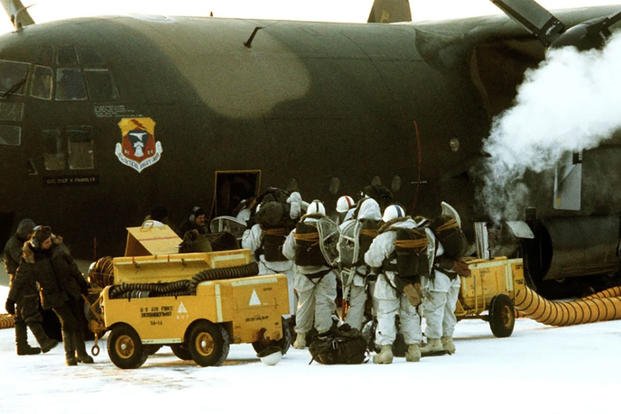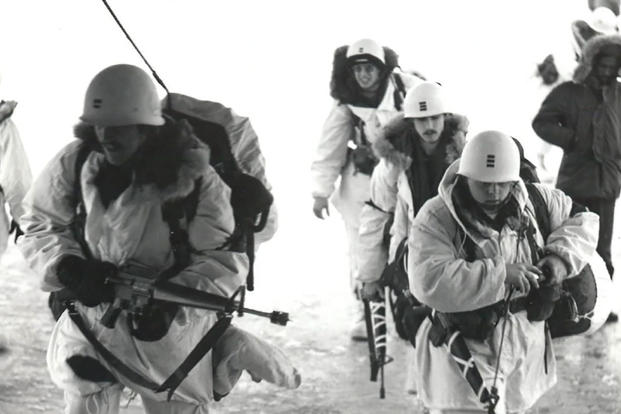
In 1971, 16 “over-the-pole” commercial flights passed over the Arctic territory between Europe and Alaska every day. Rescue operations weren’t in place to mobilize in the event of a catastrophic disaster in the remote region. If an airline crashed, nobody was coming to save them.
That is, until the US military decided to prepare for the inevitable.
The US Air Force and US Army proposed inserting a small joint-rescue team to help evacuate and provide medical first aid to plane-crash survivors in the Arctic. But before this effort obtained the proper funding and resources, the US military had to see whether such an operation was even possible. As a result, the US military commenced the first exercise of its kind, code-named Ace Band Polar Cap. The plans included the first mass airdrop of troops and heavy survival equipment onto Arctic pack ice ever attempted.
The US military assembled the perfect team for the job. According to the r, the force consisted of four Air Force H-3 helicopters from the 5040th Helicopter Squadron at Elmendorf Air Force Base, four C-130 Hercules transport planes, six Air Force combat controllers from the 17th Tactical Airlift Squadron, and one HC-130 from the 71st Aerospace Rescue and Recovery Squadron.

The combat controllers would insert ahead of the air assault force to set up navigational markers to guide the C-130s to the drop zone. In addition to the Air Force personnel, six US Army CH-47 helicopters from Fort Wainwright and approximately 130 “Arctic” Rangers belonging to O Company, 75th Infantry, from Fort Richardson, Alaska, joined the effort. These so-called Arctic Rangers, many of whom served with long-range reconnaissance patrols in Vietnam, were an elite group specializing in winter warfare.
Before the teams were inserted onto the ice cap, a drop zone had to be identified. On March 1, 1971, two US Air Force H-3 helicopters departed Point Barrow, Alaska — the last bastion of civilization just beyond the shores of the frozen Arctic Ocean — en route to their destination somewhere above the Arctic Circle.
The helicopters flew approximately 120 miles until they found an ice pack capable of withstanding a military airdrop. Capt. James McBride, the project officer assigned to the 17th Tactical Airlift Squadron, later explained to the how difficult locating a good drop zone was. The ice cap’s features included unstable ice ridges, and the Arctic Ocean’s frigid waters had reached the cap’s surface, making the prospect of landing heavy survival supplies extremely dangerous.
The next day, three combat controllers — Capt. Jerry Kitchen, Tech. Sgt. John Norsworthy, and Staff Sgt. Allen Hooper — arrived by helicopter to mark the area deemed suitable for military operations and set up a staging area for the rest of the rescue team.
On March 4, Maj. James Waldman leaped from a C-130 Hercules aircraft passing approximately 1,500 feet above the snowy white abyss of the marked drop zone. Two more members of his combat control team followed behind, floating under the canopies of their parachutes through the sub-freezing air. When the commandos landed in 8-12 feet of lightly crusted snow, they regrouped with the other combat controllers on the ground and prepared for the airdrop scheduled to arrive a few hours later.

Immediately, the team set up portable navigational equipment to guide more C-130s to their designated drop zones near the simulated crash site. One by one, three C-130s carrying 9,200 pounds of survival equipment and the US Army Arctic Rangers spilled their cargo onto the ice cap. The Arctic Rangers secured tents, rations, stoves, 28 fiberglass snow sleds, and other mission-essential equipment once they reached the ground. Some carried loaded weapons to handle any polar-bear encounters that might have arisen.
The commandos landed without a hitch — all except for Waldman. The team of combat controllers had jumped with large, heavy packs filled with survival gear, snow shoes, and communications equipment. These cumbersome rucksacks were tethered to a line designed to drop below their legs just before touchdown. The cable lock on Waldman’s pack failed to release, which caused him to land on his back in more than a foot of snow.
Because of the immense weight of the pack on his chest, he could not sit up and remained stuck in the snow. Waldman managed to remove his gloves and retrieve a knife, and he’d begun to cut the line as the exposed skin on his fingers began to show early signs of frostbite. The temperature was recorded at negative 38 degrees Fahrenheit. With wind chill, the temperature plummeted to negative 70 degrees. Waldman’s teammates slogged through the snow and freed him from his pack before his frostbite worsened.
Despite the team successfully establishing a landing zone and a hypothetical evacuation plan, the US military deemed it necessary to develop a more comprehensive rescue plan. The Arctic Rangers conducted another mock rescue the following year but were re-tasked to St. Lawrence Island in the Bering Sea, approximately 47 miles from Soviet territory, to conduct combat surveillance and other anti-Soviet activities. In 1972, just two years after their inception, the Arctic Rangers were disbanded. The decision came after the Arctic Rangers’ commanding officer, Gen. James F. Hollingsworth, left for Vietnam.
Source: Military News



